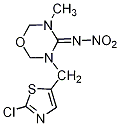
NOMENCLATURE
Common name thiaméthoxame ((
m) F-ISO); thiamethoxam (BSI, E-ISO)
IUPAC name 3-(2-chloro-1,3-thiazol-5-ylmethyl)-5-methyl-1,3,5-oxadiazinan-4-ylidene(nitro)amine
Chemical Abstracts name 3-[(2-chloro-5-thiazolyl)methyl]tetrahydro-5-methyl-
N-nitro-4
H-1,3,5-oxadiazin-4-imine
CAS RN [153719–23–4] EC no. 428–650–4
PHYSICAL CHEMISTRY
Mol. wt. 291.7
M.f. C
8H
10ClN
5O
3S
Form Crystalline powder.
M.p. 139.1 °C
V.p. 6.6 × 10
-6 mPa (25 °C)
Kow logP = –0.13 (25 °C)
Henry 4.70 × 10
-10 Pa m
3 mol
-1 (calc.)
S.g./density 1.57 (20 °C)
Solubility In water 4.1 g/l (25 °C). In acetone 48, ethyl acetate 7.0, dichloromethane 110, toluene 0.680, methanol 13,
n-octanol 0.620, hexane <0.001 (all in g/l).
Stability Stable at
pH 5;
DT50 640 d (pH 7), 8.4 d (pH 9) (unstated temperature) (
EU Rev. Rep.).
APPLICATIONS
Biochemistry Agonist of the nicotinic acetylcholine receptor, affecting the synapses in the insect central nervous system.
Mode of action Insecticide with contact, stomach and systemic activity. Rapidly taken up into the plant and transported acropetally in the xylem.
Uses For control of aphids, whiteflies,
thrips, ricehoppers, ricebugs, mealybugs, white grubs, Colorado potato beetle, flea beetles, wireworms, ground beetles, leaf miners and some lepidopterous species, at application rates from 10 to 200 g/
ha (R. Senn
et al.,
loc. cit.). Major crops for foliar and soil treatments are cole crops, leafy and fruity vegetables, potatoes, rice, cotton, deciduous fruit, coffee, citrus, tobacco and soya beans; for seed treatment use, maize, sorghum, cereals, sugar beet, oilseed rape, cotton, peas, beans, sunflowers, rice and potatoes. Also for control of flies (such as
Musca domestica,
Fannia canicularis and
Drosophila spp.) in animal and public health.
Formulation types FS;
GR;
SC;
WG;
WS.
ENVIRONMENTAL FATE
Animals Quickly and completely absorbed, rapidly distributed in the body and rapidly eliminated. The toxicokinetics and metabolism are not influenced by the route of administration, the dose level, pre-treatment, the site of label or the sex of animals. The major metabolic pathways are essentially the same in rats as in mice, goats and hens.
Plants Degradation/metabolism has been studied in 6 different crops with soil, foliar and seed treatment application. The qualitative metabolic pattern was similar for all types of applications and for all studied crops.
Soil/Environment Soil
DT50 7–109 d (field, 37 soils, median 32.3 d).
Koc 32.5–237 ml/g
o.c. (25 soils, mean 68.4 ml/g o.c.). Photolysis accelerates degradation in soil. Stable in water under acid conditions, hydrolysed under alkaline conditions. DT
50 in surface water 7.9–39.5 d (lab., darkness, 7 water-sediment systems, mean 21.5 d). Aqueous photolysis occurs rapidly. No bioaccumulation. No significant volatilisation; efficiently degraded in air by photochemical oxidative degradation.
MAMMALIAN TOXICOLOGY
Oral Acute oral
LD50 for rats 1563 mg/kg.
Skin and eye Acute percutaneous
LD50 for rats >2000 mg/kg. Non-irritating to skin and eyes (rabbits). Not a skin sensitiser (guinea pigs).
Inhalation LC50 (4 h) for rats >3720 mg/m
3.
NOEL NOAEL (90 d) for mice 10
ppm (14.3 mg/kg b.w. daily); (1 y) for dogs 150 ppm (4.05 mg/kg b.w. daily).
ADI (
EC) 0.026 mg/kg
b.w. [2006]; (company proposal) 0.041 mg/kg b.w.
Toxicity class WHO (a.i.)
III (company classification).
EC classification Xn;
R22| N;
R50,
R53|
concn. dep.
ECOTOXICOLOGY
Birds Acute oral
LD50 for bobwhite quail 1552, mallard ducks 576 mg/kg. Dietary
LC50 for bobwhite quail and mallard ducks >5200 mg/kg.
Fish LC50 (96 h) for rainbow trout >100, bluegill sunfish >114, sheepshead minnows >111 mg/l.
Daphnia EC50 (48 h) >100 mg/l.
Algae EC50 (96 h) for green algae >100 mg/l.
Other aquatic spp. LC50 (96 h) for mysid shrimps 6.9 mg/l;
EC50 (96 h) for eastern oysters >119 mg/l.
Bees LD50 for honeybees (oral) 0.005 μg/bee; (contact) 0.024 μg/bee.
Worms LC50 (14 d) for
Eisenia foetida >1000 mg/kg soil.
